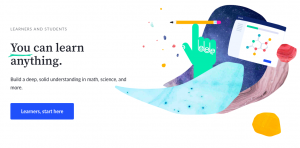
Last week, I wrote about Khan Academy and its success as an online education platform. I presented some of the technical aspects that led to its success, such as the ten-minute time limit of its videos and the customization of its lesson plans. Partnerships with other institutions also boosted its success, as it was embraced by public school systems and the United States College Board. Moreover, its partnership with internet giant YouTube was also a major contributor its global popularity. Through this effort, Khan Academy receives funds to create more videos, and these videos are streamlined into Youtube’s new Learning Playlist feature. As I read on about the current state and future developments of Khan Academy, I wanted to learn more about how it started and what other elements have helped paved its success. The story is pretty interesting and quite inspiring.
Khan Academy was founded by Sal Khan, a former hedge fund analyst (Khan Academy, 2019). In 2004, he began to tutor his cousin who lived in another state. Due to the geographical distance, tutoring sessions were held through their mobile phones and Yahoo Doodle. At this time, his cousin was having a hard time in math, even though she aspired to make it to the advanced math track. As Sal tutored her, her math skills greatly improved, so much so that he also began to teach his other family members. Because this was initially done in real time, scheduling became an issue. With his full-time job, he could not teach several people during different parts of the day. Hence, he recorded videos, which were watched by his tutees at their own convenience. By 2009, Sal quit his hedge fund job and decided to work on Khan Academy full-time. He then received donations from big companies, such as Google and the Bill and Melinda Gates Foundation.
It is exciting to witness how something rather small turned into a global educational giant. In one interview, Sal mentioned that he had to get over the fact that at that time, YouTube was mainly used for anything but education. He said, “YouTube? YouTube was for cats playing the piano, not serious mathematics… I got over the idea that it wasn’t my idea and decided to give it a shot” (Adams, 2013). Now, Khan Academy is able to provide education to anyone in the world, fulfilling their mission to provide a free, word-class education to anyone, anywhere (Khan Academy, 2019). That is truly inspiring.
Through Khan Academy, education is approached in an entirely different way. This is what makes the difference, and this is what makes students learn more effectively. Shantanu Sinha (2017) shares some of the practices of Khan Academy that cause students to learn more efficiently:
- Independence
Students are free to learn anytime and anywhere they want. This gives them a sense of responsibility and freedom, which is a contrast from the traditional classroom setting. Students are free to choose what subjects they want to learn, which topics they should pay more attention to or practice more, and how much time they want to allot to a particular concept. When students are given the opportunity to make decisions regarding their learning by themselves, then motivation comes from within, and learning is more effective.
- Content
I have already mentioned this in my previous post, but I think it is worth mentioning again. The content is short and easily understood. Just the right amount of principles is introduced, so students are not overwhelmed by a sudden influx of new information. Moreover, students can pause and review any principle that is unclear.
- Process
Khan Academy also designs lesson plans that help students understand difficult and complex topics more. There is a clear path to learning concepts that are hard to grasp, and so students are, in a way, eased into more difficult lessons. Since this is also individualized, students do not feel ashamed about the time it takes for them to learn a concept.
- Interaction
Students are not merely “taught”, but can participate in interactive learning. Ideas are not simply fed to them, but are introduced in personalized ways. Moreover, this also increases the self-efficacy of students in their own learning.
- Monitoring
Data that is provided by Khan Academy helps teachers monitor progress and provide support for students who are in need of it. This allows teachers not just to identify the concepts that are difficult to grasp, but also the individual learning styles and speeds of their students.
I remain excited by the progress of Khan Academy and its impact on the approach to education. I think it is a great resource not just for students, but for teachers all over the world. Moreover, educational systems can take a lesson or two from its principles, making education more accessible and appropriate for any learner.
Sources:
Adams, R. (2013 April 23). Sal Khan: The Man Who Tutored His Cousin—and Started a Revolution. The Guardian. Retrieved from https://www.theguardian.com/education/2013/apr/23/sal-khan-academy-tutored-educational-website
Khan Academy. (2019 July). What is the History of Khan Academy? Khan Academy. Retrieved from https://khanacademy.zendesk.com/hc/en-us/articles/202483180-What-is-the-history-of-Khan-Academy-
Sinha, S. (2017, December 06). Does Khan Academy Really Work? HuffPost. Retrieved from https://www.huffpost.com/entry/does-khan-academy-really_b_946969
